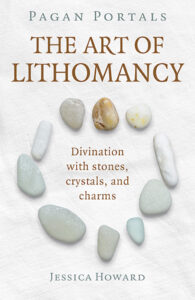The Art of Lithomancy: Divination with stones, crystals, and charms
Jessica Howard
Pagan Portals
Moon Books, 2022. 104 p. ISBN 978-1-78904-914-5 (paperback, £9.99 / $12.95), ISBN 978-1-78904-915-2 (e-book, £4.99 / $6.99)
The Art of Lithomancy is a well-chosen title. Divination is rightly considered a form of art: a diviner looks at stones or other objects for patterns with possible meanings, like a sculptor can see a possible statue in a piece of marble. The artist liberates the statue from the marble; the diviner liberates the meanings from the patterns.
Creative and performative artists are often asked: “How did you make it? How did you do that?” and in this booklet in the Pagan Portals series, Jessica Howard answers the question. She doesn’t describe the one and only way ‘how it has to be done’, but she tells ‘how she does it’, and gives lots of suggestions to work with, to choose from, to be inspired by, and to modify to match your own needs and interests. Generally, it’s not much appreciated when someone’s artworks are exactly like someone else’s. You have to develop your own style. But you start by looking how other artists work; imitating methods, picking up ideas, experimenting.
Stones are often thought of as very old beings, who experienced much and have acquired a wisdom they can share with us. To learn what they might have to tell, you can buy colourful crystals; buy or make a set of divining stones adorned with runes or other signs; or be completely natural (and aware of the ethical problems with crystal mining) using plain pebbles or other stones you’ve found yourself. You can add shells and other objects as well. Like Howard, you can create different sets. You’ll have to decide how you’ll interpret the positions of stones relative to one another, to yourself, and/or to segments within a boundary. She shows several possibilities from which you can choose or develop your own. Cleansing, charging and storing the stones before or in between use is a subject many feel important as well, and this also is dealt with, as well as ways to attune yourself to your stones, and putting yourself in the right mood for a reading.
If you panic thinking about having to memorise the meanings of no less than seventy-eight Tarot cards, to immerse yourself in Chinese philosophy in order to decipher the cryptic poetics of I Ching, or to study all the signs, planets, houses, and what have you of astrology – try lithomancy. You can start out really simple with no more than two stones, for ‘yes’ and ‘no’. If this seems too basic, a third for ‘maybe’ can be added. And then maybe a fourth, a fifth… Lithomancy can be as simple or complex as you like. Howard discusses stones with astrological symbolism; meanings associated with chakra’s and the four elements; and several personal, social and psychological aspects that often are at play when people seek answers by divination. It can be instructive to compare the suggestions in this book with your experiences in or opinions on divination and symbolism. There are about ten blank pages at the end of the book: you could use them to make notes of your own readings and comments.
Lithomancy differs from divination systems like Tarot in the greater freedom. There is not one fixed pack of cards or a set of more or less universal symbols: you can use as few or as many stones (or other objects) as suit you, with symbolism of your own choice or making. In a way it’s quite individualistic. This may ask more of your creative and intuitive powers, but at the same time could help you to train your intuition and creativity to be up to the challenge.
Howard puts forward numerous ideas and practical advice. But I’m glad she does not answer each and every possible question, leaving some latitude to work out things entirely for yourself. For example, she tells that a stone in the centre of a circle can point to the importance or nearness in time of that aspect, as opposed to a stone near the periphery indicating farther away in time or less importance. She tells that in a reading using segments of a circle to represent months of the year, a stone exactly on the line dividing January and February can be interpreted as referring to both months. In this segmented circle, a stone in the centre means that the influence will be felt throughout the year. But she also suggests the possibility of dividing the circle in three segments: past, present, and future. What if a stone falls on the line between past and future? Does it matter if it is nearer the centre of the circle, that is nearer the segment of the present; or nearer the outer boundary? You’ll have to make up your own mind about that.
If the idea of divining with stones speaks to you, but you’re unsure how or where to start, The Art of Lithomancy can pave the way. If you’d like to fine-tune or expand your skills and understanding by comparing your own approach with that of someone else, this book may be of benefit as well.


